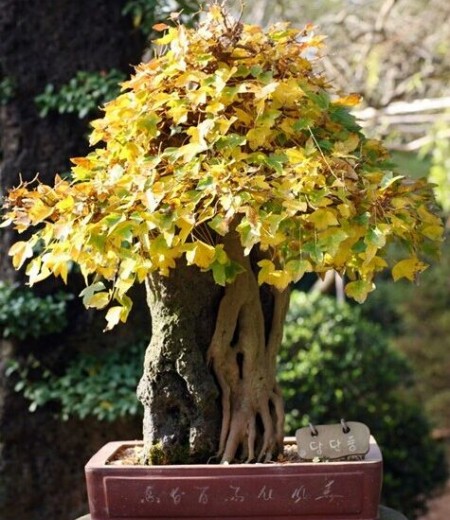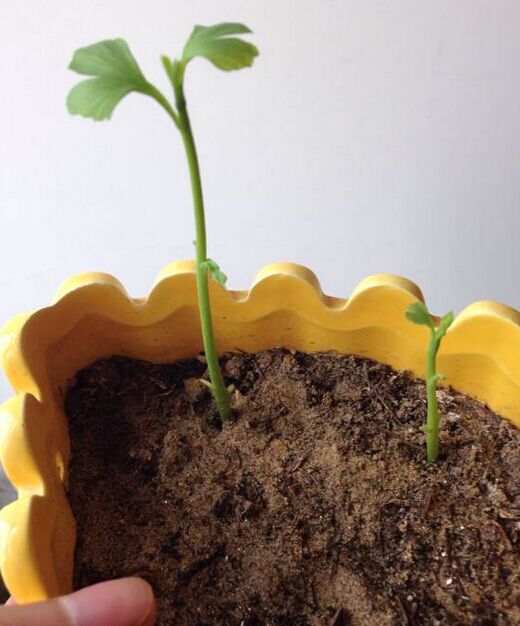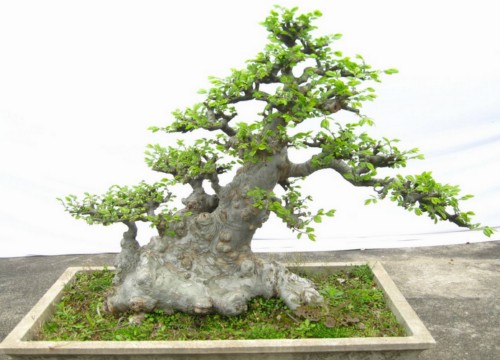The method of making bonsai with ginkgo biloba stump
When people are transforming and pruning ginkgo trees, they often cut off a lot of branches, and they can choose the best shape as interstock and quickly make ginkgo stump bonsai. There are three points for attention.

1. The root system of rootstock should be developed. Depending on the size of the interstock to determine the number of branches, generally three, into a "tripod" trend, if the interstock is thick or there are many branches, it can be four to five or more.
2. The binding should be firm. In order to ensure the corresponding mechanism at the interface during grafting, the saw blade on the interstock needs to be flattened with a sharp edge. Soak it in the rooting agent solution quickly, and then wrap several layers of paper which has been soaked in the rooting agent solution and dried. In order to form callus as soon as possible, the interface should be wrapped in thin iron sheet and tightened with wire. The width of the iron sheet is unlimited, and the length should be wound for one week without joint.
According to the different appreciation requirements of ginkgo bonsai, the modeling design pattern is drawn in advance, and the branches are bent and tied according to the figure cable shape because of the pile potential. The stump bonsai strives to be vigorous and rugged, and the stump of the old tree can be used to develop the arrogant temperament of thick trunk, curved branches and exposed roots.
3. Grafting is often carried out by the method of "skin insertion and tongue grafting". After grafting, it is directly planted in the open field or flowerpot. The effect is the best in the "peeling" period of the tree. If grafting is carried out in other periods, "split grafting" or "joint" can be used, and then callus can be induced in the greenhouse or arch shed sand. The ideal healing temperature after grafting is 20 to 30 degrees Celsius. After healing, it is taken out of the sand and planted in open fields or flowerpots. Be careful not to damage the callus and the new root point when you take it out.
The finished bonsai of ginkgo biloba should be maintained in a sunny, ventilated and humid place. Avoid drought and sun exposure in summer and bury the earth against cold in winter. In the growing season to keep the basin soil moist, once a week to apply cake fertilizer or farm fertilizer, the amount of fertilizer should be small. Basin soil as far as possible to choose high-quality nutritional soil, can add appropriate amount of sand and bran ash. Change the basin every two years, trim the long roots when changing the basin, and replace half of the old soil, and apply base fertilizer at the bottom of the basin. The growth of ginkgo bonsai is slow, the disease is less, and the maintenance and management is relatively simple.
Time: 2019-05-26 Click:
- Prev

The method of making bonsai of Ginkgo biloba seedlings
Ginkgo biloba is a deciduous tree of Ginkgo biloba family. Ginkgo biloba, which appeared hundreds of millions of years ago, is the oldest relict of gymnosperms left over from the Quaternary glacial movement. Ginkgo biloba is rare and scattered in the world, and hundreds of years old trees are rare. All other plants of the same class have become extinct.
- Next

The process of making elm bonsai
Elm trees, especially the old piles that grow in the wild, have gradually formed many different strange gestures after years of man-made chopping axe chisels, or wind and rain erosion, animal bites and so on. Some are intertwined, vigorous and simple, while others turn decay into magic, withered roots and new leaves, unique caves, and are excellent materials for making bonsai.
Related
- Fuxing push coffee new agricultural production and marketing class: lack of small-scale processing plants
- Jujube rice field leisure farm deep ploughing Yilan for five years to create a space for organic food and play
- Nongyu Farm-A trial of organic papaya for brave women with advanced technology
- Four points for attention in the prevention and control of diseases and insect pests of edible fungi
- How to add nutrient solution to Edible Fungi
- Is there any good way to control edible fungus mites?
- Open Inoculation Technology of Edible Fungi
- Is there any clever way to use fertilizer for edible fungus in winter?
- What agents are used to kill the pathogens of edible fungi in the mushroom shed?
- Rapid drying of Edible Fungi

